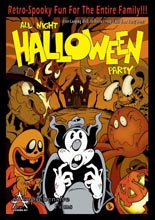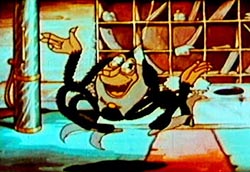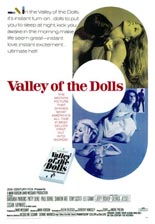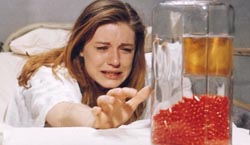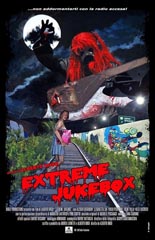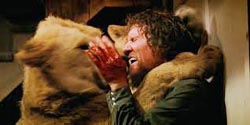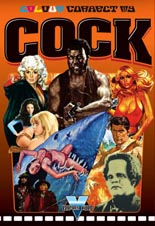
 Vagrant Video’s Colour Correct My Cock is unlike any trailer compilation on the market … in that I hesitate to utter its title in mixed company. In an insufferable six-minute skit that opens the program, we learn that the name is essentially James Bialkowski and Jacob Windatt’s petty “fuck you” to an unnamed DVD label that declined to release the collection, partly for reasons of image quality.
Vagrant Video’s Colour Correct My Cock is unlike any trailer compilation on the market … in that I hesitate to utter its title in mixed company. In an insufferable six-minute skit that opens the program, we learn that the name is essentially James Bialkowski and Jacob Windatt’s petty “fuck you” to an unnamed DVD label that declined to release the collection, partly for reasons of image quality.
Yet that company’s perceived negative is actually a positive for the intended viewer: The more “grindhouse” grimy it looks, the more welcome it is. With little exception (i.e., that sour-grapes intro), Colour Correct is indeed welcome; it’s two hours of “trailers hand selected through years of audience testing on drunken Canadian vagrants.” It worked even on this sober American.
If we nicely shove Scorchy and Blackenstein aside, Colour Correct excels at presenting coming attractions of movies you’re unlikely to see represented elsewhere — not even on Synapse Films’ excellent 42nd Street Forever line. Hell, it is doubtful cult diehards will have heard of all the films whose ads bump (and grind) against one another here — flicks like Dagmar’s Hot Pants Inc., The Thunder Kick, The Godmother II, Cracking Up.
 Highlights among the lowbrow include:
Highlights among the lowbrow include:
• A leering, jeering Tony Curtis, ostensibly at the bank to cash in his last batch of Some Like It Hot credibility, in the alleged 1977 comedy Sex on the Run.
• Death on the Run, a 1967 spy thriller that tries to sell itself as a Django sequel, just because they share a director in Sergio Corbucci.
• Disney’s infamous football-playing mule, Gus, of course starring Don Knotts.
• Killer Condom, an eventual Troma pickup stateside, here under its original German title (and denying viewers the money shot, so to speak, of the rubber rascal).
• Tomas Milian and Susan George as, irrespectively, Sonny and Jed, in a comedic Western sold with the very ’72 line, “In the Old West, an outlaw woman stood behind her man … three steps behind!”
• In 1977, Mexico does Jaws — and poorly — in René Cardona Jr.’s Tintorera: Killer Shark.
• The Seven Dwarfs to the Rescue, a 1951 live-action oddity from Italy that promises to be “Brimming with Laughter!” and “Enchanted with a Magic that will live Forever After!” I call bullshit.
• 1970’s Josefine Mutzenbacher, which just proves my theory that German porn is the most disturbing porn. (Lord, may the coin used in this trailer never circulate to these hands.)
• The 1965 Marco Polo epic, Marco the Magnificent, starring Orson Welles, Anthony Quinn and, per the narrator, “Elsa Martinelli as the girl with the whip!”
• Tom Laughlin in his post-Billy Jack Western, 1975’s The Master Gunfighter.
• And lots of women being punches for laughs in the 1976 Lee Marvin vehicle The Great Scout and Cathouse Thursday.
Even with that strong lineup, Colour Correct My Cock overflows with a wealth of vintage drive-in ads — pushing everything from the Chilly Dilly to Chuckles — and other bits of interspersed ephemera, including a Wham-O Super Ball commercial, a plea to complete the 1981 Canadian Census, an attack ad against the public scourge known as cable TV, a suggestion to give theater tickets “in gay gift envelopes,” a drunk-driving PSA from the Saskatchewan Department of Health and a pleasant thought courtesy of the California Table Grape Commission: “These summer memories have been brought to you by Grapes.”
While all this may seem random, I believe Bialkowski and Windatt actually were rather calculated in their assembly process. How else to explain ads targeting children and churchgoers being followed immediately by clips from an Asian porno? More subversively, a promo for some ungodly, wiener-based concession called Pronto Pops backs up to a depiction of fellatio so brief that while the seam between the source material may not register, thoughts of Tyler Durden manning the projection booth certainly do. —Rod Lott

